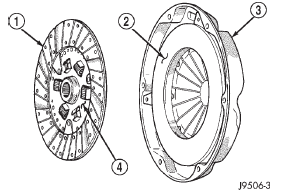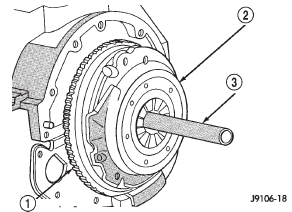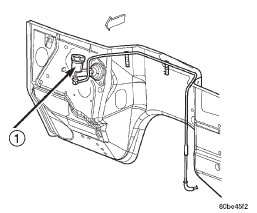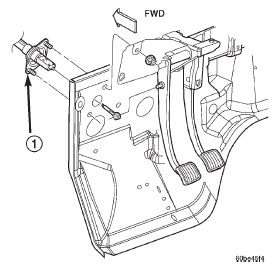Jeep Cherokee (XJ): Removal and installation
REMOVAL (1) Remove transmission. Refer to procedures in
Group 21.
(2) If original clutch cover will be reinstalled, mark
position of cover on flywheel for assembly reference.
Use paint or a scriber for this purpose.
(3) If clutch cover is to be replaced, cover bolts can
be removed in any sequence. However, if original
cover will be reinstalled, loosen cover bolts evenly
and in rotation to relieve spring tension equally. This
is necessary to avoid warping cover.
(4) Remove cover bolts and remove cover and disc
(Fig. 10). INSTALLATION (1) Lightly scuff sand flywheel face with 180 grit
emery cloth. Then clean surface with a wax and
grease remover.
(2) Lubricate pilot bearing with Mopar high temperature
bearing grease.
(3) Check runout and free operation of new clutch
disc as follows:
(a) Slide disc onto transmission input shaft
splines. Disc should slide freely on splines.
(b) Leave disc on shaft and check face runout
with dial indicator. Check runout at disc hub and
about 6 mm (1/4 in.) from outer edge of facing.
(c) Face runout should not exceed 0.5 mm (0.020
in.). Obtain another clutch disc if runout exceeds
this limit.
(4) Position clutch disc on flywheel. Be sure side of
disc marked flywheel side is positioned against flywheel
(Fig. 10). If disc is not marked, be sure flat
side of disc hub is toward flywheel.
(5) Inspect condition of pressure plate surface of
clutch cover (Fig. 10). Replace cover if this surface is
worn, heat checked, cracked, or scored.
(6) Insert clutch alignment tool in clutch disc (Fig.
11).
(7) Insert alignment tool in pilot bearing and position
disc on flywheel. Be sure disc hub is positioned
correctly. Side of hub marked Flywheel Side should
face flywheel (Fig. 10). If disc is not marked, place
flat side of disc against flywheel.
1 - DISC (8) Position clutch cover over disc and on flywheel
(Fig. 11).
(9) Install clutch cover bolts finger tight.
(10) Tighten cover bolts evenly and in rotation a
few threads at a time. Cover bolts must be tightened
evenly and to specified torque to avoid
distorting cover. Tightening torques are 31 N·m
(23 ft. lbs.) on 2.5L engines and 50N·m (37ft. lbs.)
on 4.0 L engines.
(a) Start all 6 bolts by hand.
(b) Tighten 3 pilot hole bolts 3/4s of the way
(any sequence).
1 - FLYWHEEL (c) Starting 180 degrees from the last pilot bolt,
tighten 3 large hole bolts 3/4s of the way (any
sequence).
(d) Tighten 3 pilot hole bolts all the way (any
sequence).
(e) Starting 180 degrees from last pilot bolt,
tighten 3 large bolts all the way (any sequence).
(11) Apply light coat of Mopart high temperature
bearing grease to clutch disc hub and splines of
transmission input shaft. Do not over lubricate
shaft splines. This will result in grease contamination
of disc.
(12) Install transmission. REMOVAL (1) Remove transmission.
(2) Disconnect release bearing from release lever
and remove bearing (Fig. 12).
(3) Inspect bearing slide surface of transmission
front bearing retainer. Replace retainer if slide surface
is scored, worn, or cracked.
(4) Inspect release fork and fork pivot. Be sure
pivot is secure and in good condition. Be sure fork is
not distorted or worn. Replace release fork retainer
spring if bent or damaged. INSTALLATION (1) Lubricate crankshaft pilot bearing with Mopart
high temperature bearing grease. Apply grease to
end of long shank, small diameter flat blade screwdriver.
Then insert tool through clutch disc hub to
reach bearing. (2) Lubricate input shaft splines, bearing retainer
slide surface, fork pivot and release fork pivot surface
with Mopart high temperature grease.
(3) Install new release bearing. Be sure bearing is
properly secured to release fork.
(4) Install transmission.
1 - RETURN SPRING REMOVAL (1) Remove transmission. Refer to Group 21,
Transmission and Transfer Case, for proper procedures.
(2) Remove clutch cover and disc.
(3) Use a suitable blind hole puller to remove pilot
bearing. INSTALLATION (1) Clean bearing bore with solvent and wipe dry
with shop towel.
(2) Lubricate new pilot bearing with Mopart high
temperature grease.
(3) Position and start new bearing in bearing bore
by hand. Note that pilot bearing has seal at one end.
Install bearing so seal is facing outward toward
transmission.
(4) Seat pilot bearing with clutch alignment tool
(Fig. 13). Keep bearing straight during installation.
Do not allow bearing to become cocked. Tap bearing
into place until flush with edge of bearing bore. Do
not recess bearing.
(5) Install transmission. Refer to Group 21, Transmission
and Transfer Case, for proper procedures.
1 - PILOT BEARING The clutch housing is removable and can be
replaced when the transmission is out of the vehicle.
The bolts attaching the housing to the transmission
case are located inside the housing (Fig. 14).
Recommended tightening torque for the clutch housing-
to-transmission bolts is 46 N·m (34 ft. lbs.).
NOTE: Be sure the transmission and housing mating
surfaces are clean before installing an original,
or replacement clutch housing. Dirt/foreign material
trapped between the housing and transmission will
cause misalignment. If misalignment is severe
enough, the result will be clutch drag, incomplete
release and hard shifting. The clutch master cylinder, slave cylinder and connecting
line are serviced as an assembly only. The
linkage components cannot be overhauled or serviced
separately. The cylinders and connecting line are
sealed units. Also note that removal/installation procedures
for right and left hand drive models are basically
the same. Only master cylinder location is
different.
Fig. 14 Clutch Housing Attachment 1 - HOUSING-TO-TRANSMISSION BOLTS (46 N·m/34 ft. lbs.) REMOVAL (1) Raise vehicle.
(2) Remove fasteners attaching slave cylinder to
clutch housing.
(3) Remove slave cylinder from clutch housing
(Fig. 15).
(4) Disengage clutch fluid line from body clips, if
applicable.
(5) Lower vehicle.
(6) Verify that cap on clutch master cylinder reservoir
is tight. This is necessary to avoid spilling fluid
during removal.
(7) Remove clutch master cylinder attaching nuts
(Fig. 16) or (Fig. 17).
(8) Disengage captured bushing on clutch master
cylinder actuator from pivot pin on pedal arm (Fig.
18).
(9) Slide actuator off pivot pin.
(10) Disconnect clutch interlock safety switch
wires.
(11) Remove clutch hydraulic linkage through
engine compartment.
1 - CLUTCH SLAVE CYLINDER
1 - CLUTCH MASTER CYLINDER INSTALLATION (1) Be sure reservoir cover on clutch master cylinder
is tight to avoid spills.
(2) Position clutch linkage components in vehicle.
Work connecting line and slave cylinder downward
past engine and adjacent to clutch housing (Fig. 16)
or (Fig. 17).
1 - CLUTCH MASTER CYLINDER
1 - CLUTCH MASTER CYLINDER (3) Position clutch master cylinder on dash panel
(Fig. 16) or (Fig. 17).
(4) Attach clutch master cylinder actuator to pivot
pin on clutch pedal (Fig. 18).
(5) Install and tighten clutch master cylinder
attaching nuts to 38 N·m (28 ft. lbs.) torque.
(6) Raise vehicle.
(7) Insert slave cylinder push rod through clutch
housing opening and into release lever. Be sure cap
on end of rod is securely engaged in lever. Check this
before installing cylinder attaching nuts.
(8) Install and tighten slave cylinder attaching
nuts to 23 N·m (17 ft. lbs.) torque. (9) Secure clutch fluid line in body and transmission
clips.
(10) Lower vehicle.
(11) Connect clutch interlock safety switch wires.Clutch cover and disc

Fig. 10 Clutch Disc And Pressure Plate Inspection
2 - INSPECT THIS SURFACE
3 - CLUTCH COVER
4 - "FLYWHEEL SIDE" STAMPED ON THIS SURFACE
Fig. 11 Typical Method Of Aligning Clutch Disc
2 - CLUTCH COVER AND DISC
3 - CLUTCH DISC ALIGNMENT TOOLRelease bearing

Fig. 12 Release Bearing Attachment
2 - PIVOT BALL STUD
3 - CLUTCH HOUSING
4 - RELEASE FORK
5 - RELEASE BEARINGPilot bearing

Fig. 13 Typical Method Of Installing Pilot Bearing
2 - ALIGNMENT TOOL
3 - BEARING SEAL MUST FACE TRANSMISSIONClutch housing
Clutch hydraulic linkage

2 - CLUTCH HOUSING
3 - TRANSMISSION
Fig. 15 Slave Cylinder
Fig. 16 Left Hand Drive Clutch Master Cylinder
Fig. 17 Right Hand Drive Clutch Master Cylinder
Fig. 18 Clutch Pedal Attachment
Other materials:
Valve timing. Valve, guide and seal. Piston-fitting
Valve timing
Disconnect the spark plug wires and remove the
spark plugs.
Remove the engine cylinder head cover.
Remove the capscrews, bridge and pivot assembly,
and rocker arms from above the No.1 cylinder.
Alternately loosen each capscrew, one turn at a
time, to avo ...


